Employee profile editing
Overview of the employee profile settings.
This topic provides a full overview of the employee profile details. The basic fields and settings are discussed in the Manually create an employee article, so here you'll get familiar with the additional settings that become available after creating the employee profile. Nevertheless, in the case of basic fields, there are some aspects that are different when creating an employee profile and when editing it.
PERMISSIONSYour role needs to have View employee profile and Edit employee profile permissions under Web App > Administration > Role Permissions > Employees to be able to view and edit the profile after creation.
Role change
There is a dedicated role permission for changing the employee role, which is applied when editing the employee role and not when creating it.
PERMISSIONSYour role needs to have a Change employee role permission under Web App > Administration > Role Permissions > Employees to be able to change the role.
Organization unit
Update the main organization unit of the employee or assign additional organization units.
VISIBILITYYou may assign main and additional organization units only if your MobiClocks environment is converted to an enterprise structure.
The option to assign additional organization units is available if the Additional organization unit setting is enabled in Administration > Organization unit. The following screenshot shows the Organization unit and Additional organization unit(s) fields in the employee profile.

Organization unit and Additional organization unit(s) fields
Select Add organization unit to add one or more additional organization units.
See Additional organization units to learn about the access and visibility rules that guide collaboration across main and additional organization units.
Company change
If you attempt to change the employee's company, you’ll see a date picker to schedule the transfer date.
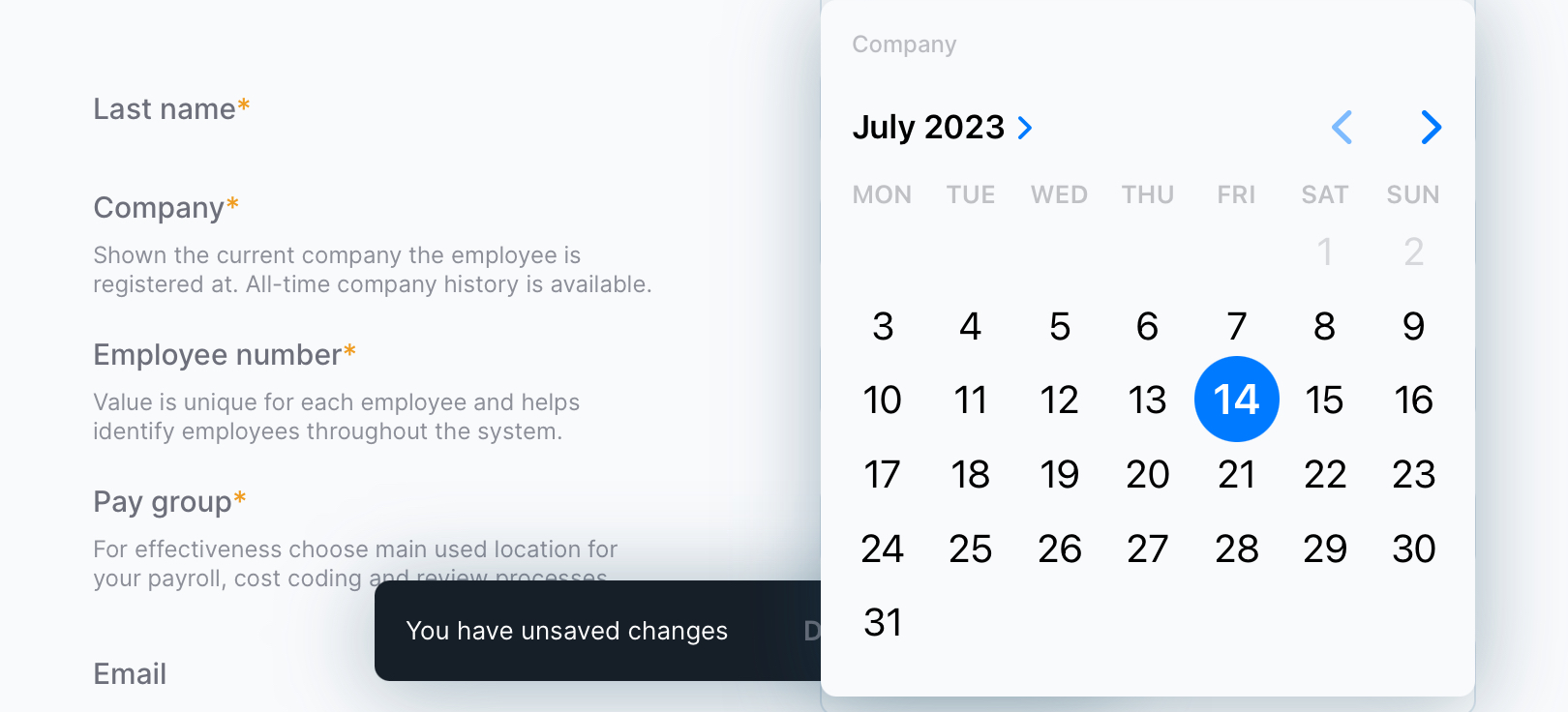
Scheduling company change
Depending on the scheduling settings (weekly or biweekly scheduling) configured in the MobiClocks Admin Portal, your past date selection range will be either 1 (in case of weekly scheduling) or 2 (in case of biweekly) weeks. This means that, in case of weekly scheduling, the earliest date that you are able to select for transfer is one week before your current date. Same transfer date rules apply for Pay Group change, which are discussed shortly.
PERMISSIONSYour role needs to have an Employee company change permission under Web App > Administration > Role Permissions > Employees to be able to change the company after you’ve already set it.
Profile Info
This section discusses the rest of the settings under the Profile Info section of the employee profile, which are not discussed in Manually create an employee, as they appear only after the employee profile is created. The following screenshot shows the fields that are discussed.
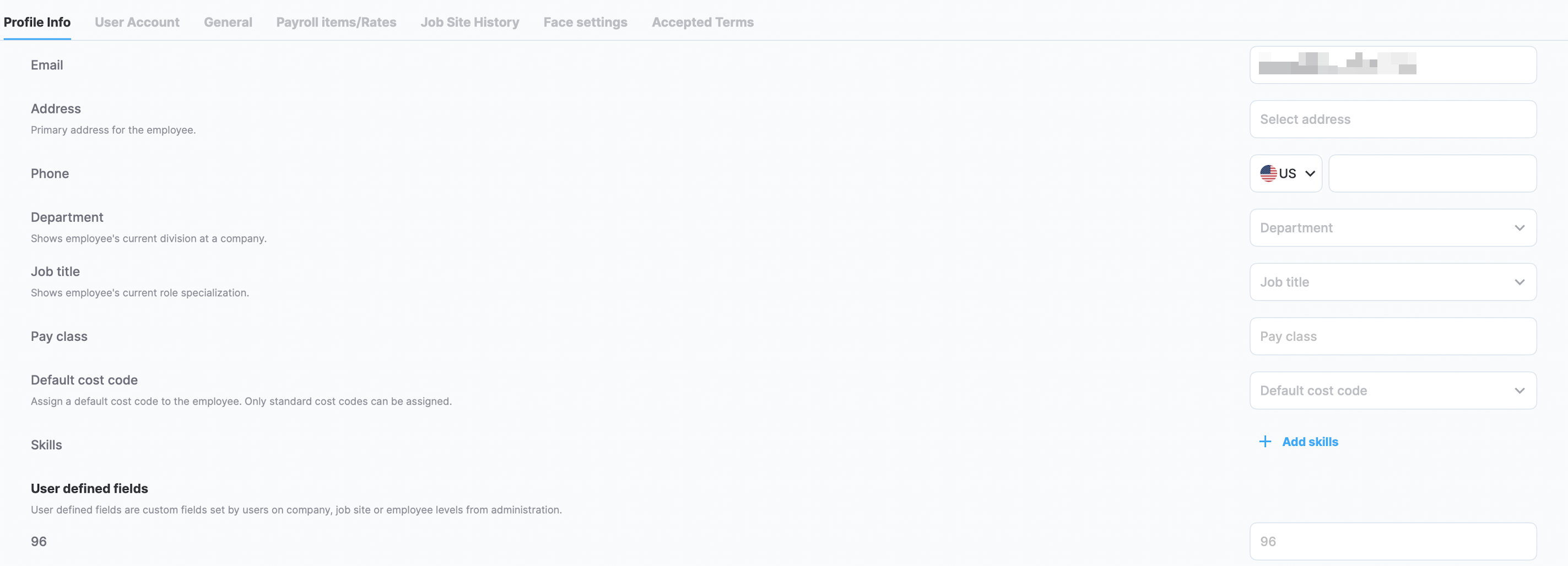
Profile Info fields
The following fields are included:
- Email and Phone Number. Here you can specify employee's email and phone number, which are also used to activate the employee's user account.
-
NOTE
You will need to specify the Email to be able to create a User Account for the employee. Meanwhile, user account activation can be done either via email or phone (sms verification).
- Address. Specify the employee's address.
- Job title and Department. The options for these fields are defined in Administration > Settings > Employee Setup. If no values are specified for these fields, they aren't shown in Profile info.
- Pay class. Here, you can specify a pay class for an employee, which can be different from the pay classes set for job sites. See Pay classes for more details.
- Default cost code. Specify a default cost code for the employee to be used for applying cost codes automatically.
- Skills. You can assign skills to the employee. The list of available skills is specified under Administration > Tag Management > Employee Skills.
- User defined fields. Here, all the custom fields added for your environment under Administration > Settings > User Defined Fields > Employee. are shown.
User Account
Creating a user account for an employee is optional, but it’s needed to let employees perform actions, such as punching in to a job sites, from their personal devices or other MobiClocks apps.
PERMISSIONSYour role needs to have a Change user account settings permission under Web App > Administration > Role Permissions > Employees to be able to create and configure user accounts.
The user account needs to be created manually after creating the employee profile. To do that, navigate to the User Account tab in the employee profile and select the Create account button, as shown in the following screenshot.
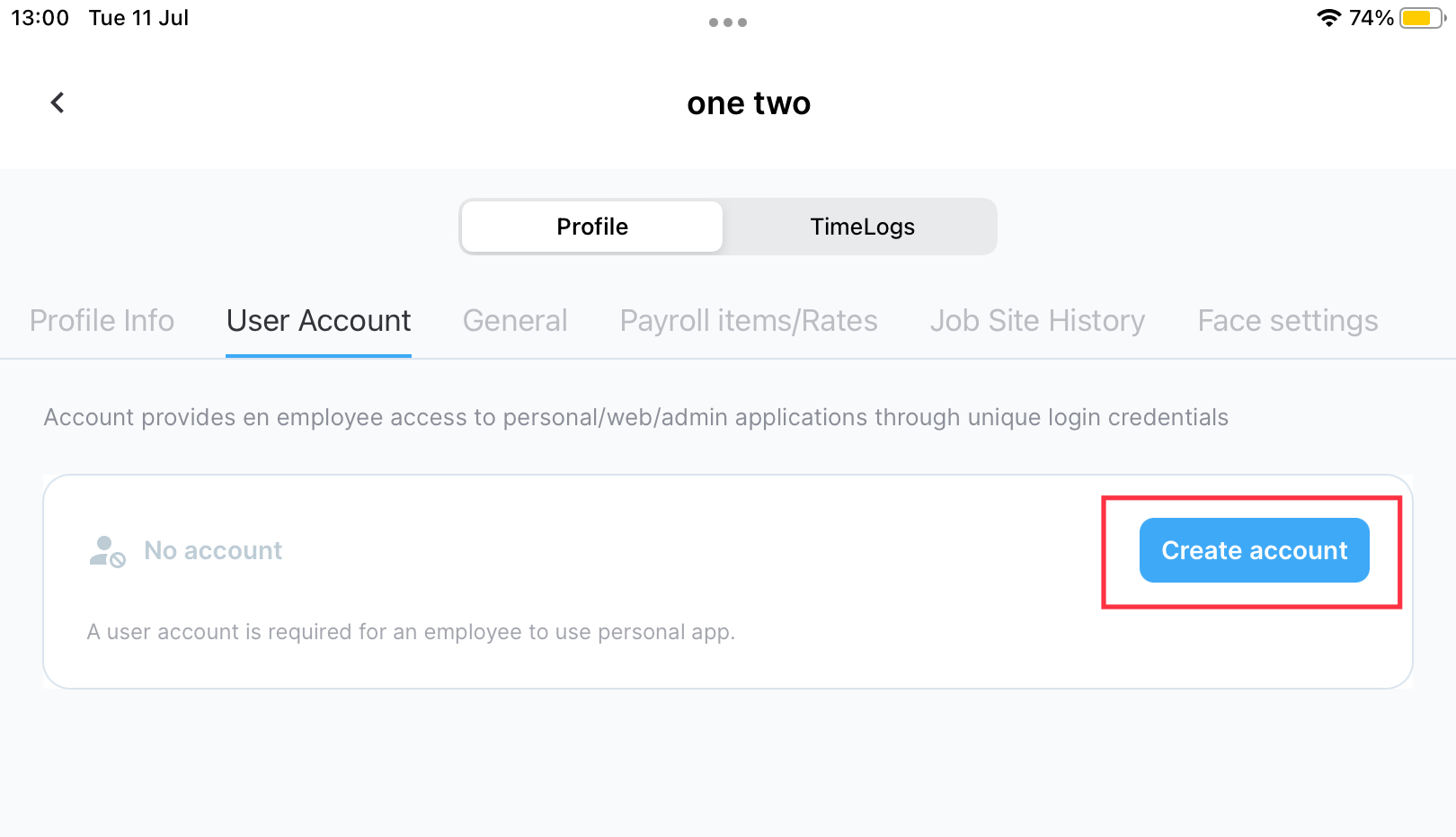
Create account button
Next, you’ll need to choose the verification method. If the employee profile has both email and phone number specified, you’ll have both options to choose from. The following screenshot shows the verification dialog box.
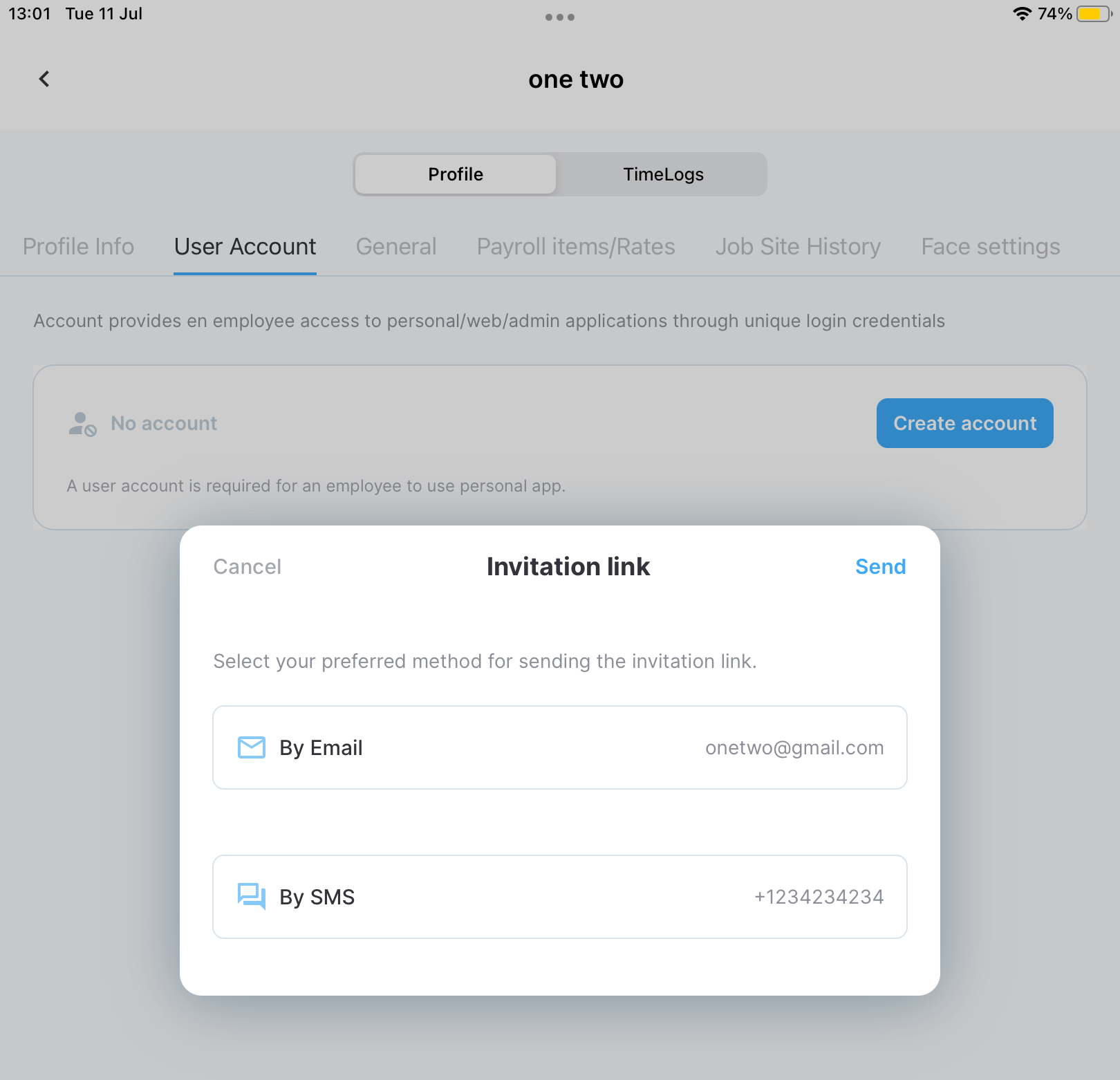
Selecting a user account activation method
After choosing the preferred option, select the Send button. The employee will receive an email or an sms with a link to set up a personal account through the MobiClocks Web App or by downloading the MobiClocks Personal App.
As soon as the employee sets up the account, you’ll be able to access the user account details and will also see a Created badge at the top of the User Account tab.

User account status and actions
Note that you also have two actions next to the badge: Reset password and Disable. The first one lets you send password reset instructions to the employee’s email, while the second one lets you disable the user account, preventing the employee from accessing it.
Now that you’ve set up a user account for the new employee, you can proceed with configuring some additional parameters for the account.

User account settings
First comes the Username, which employees will use for their accounts. By default, it borrows the employee’s email as its value, but you can customize it.
Next, you have the Role permission settings. New employees are automatically assigned the permissions that are defined for their roles in Web App > Administration > Role Permissions, but here you are able to view the complete list of employee permissions and override any of those for the given employee.
PERMISSIONSYour role needs to have an Employee permission override permission activated under Web App > Administration > Role Permissions > Employees to be able to edit employee permissions.
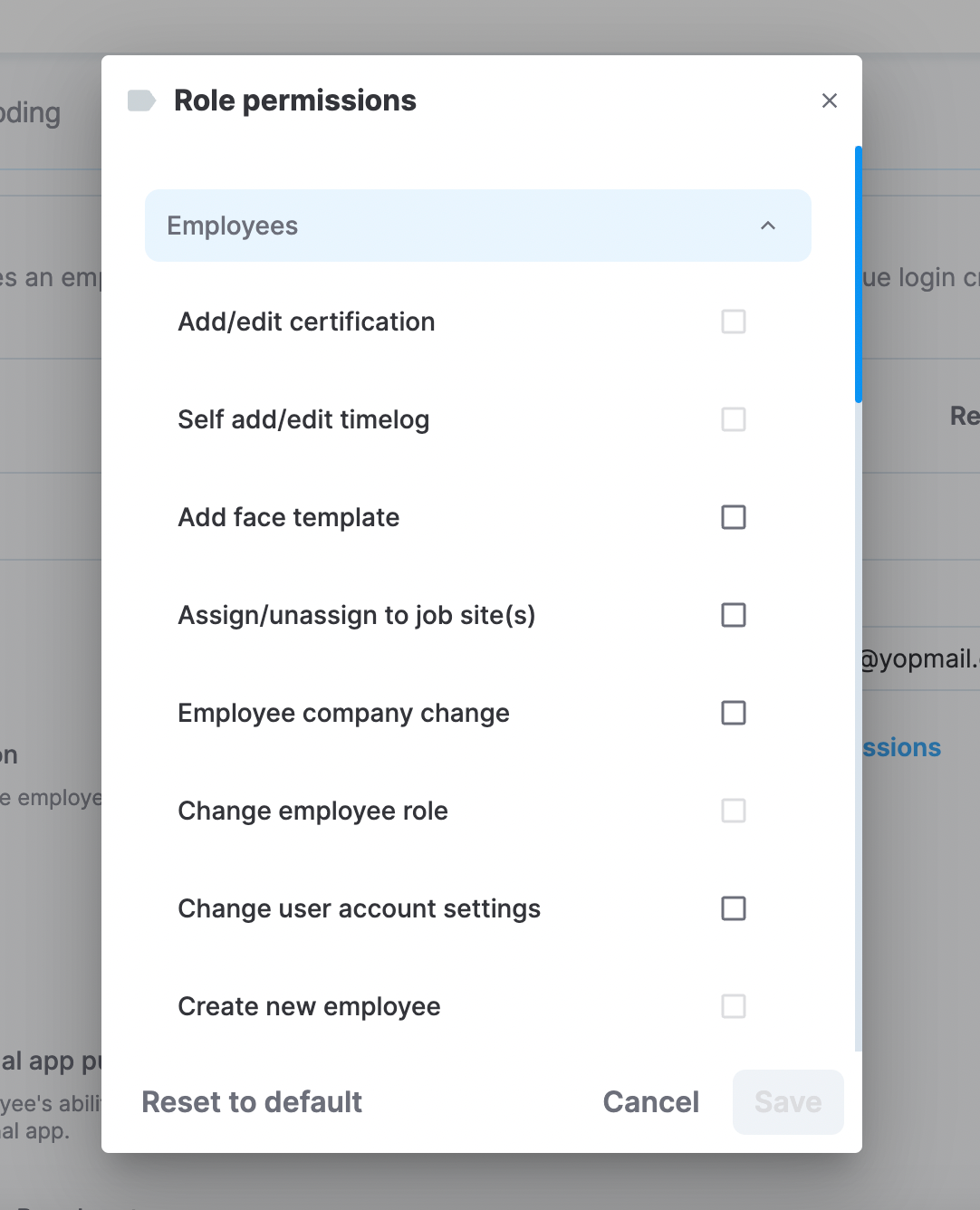
List of employee permissions
GPS tracking
If GPS tracking is enabled, you’ll be able to track the employee’s location. The frequency with which the coordinates are stored and sent to the system is specified through Getting interval and Sending interval. If you don’t modify these two, the default values set in Administration > Settings > GPS are used.
Settings
Following the GPS tracking settings is the Settings section, where you have several additional options for managing what the employee can do through the personal app.
Here’s the list of the available settings:
- Allow personal app punches. Let employees punch into and out of the job site using their personal app.
- Cost code on punch out. The employee will be asked to cost code all the timelogs on punch out.
- Geofence lock. If the option is enabled, the employees will only be able to punch into a job site if they are within the job site's geofence lock. See Geofence zones for more information.
- Roaming employee. Employees are able to punch into any job site regardless of the job sites assigned to them.
Signed-in device
Lastly, the User Account tab has a Signed-in devices list where all the signins along with Device model, OS, Signin date, and other parameters are logged.
General
Meal Break
VISIBILITYMeal Break settings become available in the employee profile if Meal Break Policy is activated from Web App > Administration > Settings > Meal & Rest Break.
Additionally, Meal Break Policy settings don't appear if the employee's pay group is set to
Salary.
The meal break settings in the employee profile are only applicable if the job site's meal break policy is set to Fixed. The following settings are available:
- Auto-apply. Automatically apply the selected break duration to the employee's timelogs. If this setting is deactivated, you can apply a fixed meal break to a timelog from the timelogs list.
NOTE
The auto-apply toggle needs to be on both in job site settings and employee profile for the feature to be applied.
- Duration. The duration of the break. This overrides the value set in Fixed Meal Policy settings in job site settings.
PERMISSIONSYour role needs to have the Edit Meal/Rest Break Policy permission activated under Web App > Administration > Role Permissions > Employees to be able to edit Meal Break Policy settings.
Rest Break
VISIBILITYRest Break settings become available in the employee profile if Rest Break Policy is activated from Web App > Administration > Settings > Meal & Rest Break.
Additionally, Rest Break Policy settings don't appear if the employee's pay group is set to
Salary.
The following settings are available:
- Auto-apply. Automatically apply the selected break duration to the employee's timelogs. If this setting is deactivated, you can apply a fixed rest break to a timelog from the timelogs list.
NOTE
The auto-apply toggle needs to be on both in job site settings and employee profile for the feature to be applied.
- Duration. The duration of the break. This overrides the value set in Rest Break Policy settings in job site settings.
PERMISSIONSYour role needs to have the Edit Meal/Rest Break Policy permission activated under Web App > Administration > Role Permissions > Employees to be able to edit Rest Break Policy settings.
Other
You have the following settings under Other:
- Policy group. Pay policy groups (include parameters such as work day duration, work week duration, and others) are set up in Administration > Pay Policy > Policy Groups, and here you can choose any of the available options or leave the default pay policy.
- Leave of absence. For each working day, an empty timelog is automatically generated and is then filled in by the employee. If this toggle is enabled, no timelog will be generated for the employee when on leave of absence.
Non eligible for rehire
If this setting is activated, you are not able to re-activate the employee profile if it has been disabled. See Manually create an employee for more information on employee profile status.
PERMISSIONSYour role needs to have an Enable/disable employee permission activated under Web App > Administration > Role Permissions > Employees to be able to disabe an employee profile.
Ignore job site hours policy
This setting allows an employee to punch at any job site regardless of the job site's working hours policy.
NOTEIf the Ignore job site hours policy is activated
- It prevents the Auto-adjust punches to work hours setting from being applied if it's enabled in the job site's working hours policy settings.
- The Lock hours option in the job site's working hours policy settings must be turned off so that employees are able to punch outside of working hours.
Other important behavior to note:
- When an employee is first assigned to a job site, the system automatically applies the employee profile's Ignore job site hours policy setting to that assignment. This setting can be modified later in the job site employees section.
- For existing job site assignments, changes to the Ignore job site hours policy setting in the employee profile will not affect the existing assignments. The setting in the job site employees section takes precedence.
Payroll items/Rates
Pay rates
In this section, you see the pay rates of the selected employee and can set new rates. On the highest level, pay rates are set up in company details where you can specify Company default rates as well as separate rates for each Job Title.
PERMISSIONSFor each employee pay group, you must have the corresponding permission activated in Web App > Administration > Role Permissions > Employees to be able to see their pay rates. The following are the permissions for each pay group:
- View hourly employee rate
- View salary actual employee rate
- View salary employee rate
So, if the employee profile has a Job Title that has pay rates set up for it in the employee’s company details, those pay rates are applied for the employee by default. Otherwise, company default rates are applied. The following screenshot shows an example where company default rates as well as job title-specific rates are applied.

Default and job title rates applied
NOTEThere can be cases when there is no Company default rate or Job Title rate set up. If neither of those is specified, you’ll need to set rates for each employee profile separately, which is discussed next.
Lastly, you can select the Set rates button and define rates specific to the employee.
PERMISSIONSYour role needs to have an Edit pay rates permission activated under Web App > Administration > Role Permissions > Employees to be able to set new rates for the employee.
In the dialog that opens next, you can set Hourly or Weekly rates.
Hourly rates
You can set hourly rates for the following pay IDs:
- Regular
- Double-Time
- Overtime
See Pay ID for more details on pay IDs.
Weekly rates
You can also set a weekly pay rate for the employee. Note that the weekly rate is not inherited from company details and is set on an individual employee level only. In addition, you can set either an hourly or a weekly rate for a specific employee.
Finally, as shown in the following screenshot, you have a Show History button to view the history of all the previously applied rates.

Show history button
Payroll item mapping
Payroll item mapping templates are set up in Web App > Administration > Payroll > Payroll Mapping Groups, so here you just need to select a payroll mapping that needs to be applied to the employee.
PERMISSIONSYour role needs to have the Set payroll item permission activated under Web App > Administration > Role Permissions > Employees to be able to select a payroll mapping.
See Payroll items mapping groups for more information on payroll mapping.
Job Site History
In this section, you can assign a job site to the employee as well as view the complete history of the past job sites.
To assign a new job site, you need to select the Assign job site button in the upper right corner of the screen, select a job site from the dropdown list, and select Save.
PERMISSIONSYour role needs to have the Assign/unassign to job site(s) permission activated under Web App > Administration > Role Permissions > Employees to be able to assign job sites to employees.
The first job site you assign to the employee becomes the main job site. If you assign more sites to the employee, you can select another site to be the Main one from the three dots menu on the job site entry. In the same menu, you have the option of removing the job site, which will remain in the list, having its end date changed to the date of removal.

Setting a main job site
Assign job sites from multiple org units
If your MobiClocks environment is converted to an enterprise structure, and the Additional organization unit(s) setting is enabled in Administration > Organization units, it is possible to assign job sites from multiple org units.
In this case, when assigning a job site, the selected org unit is displayed at the top and can be changed from the dropdown, as highlighted in the following screenshot.
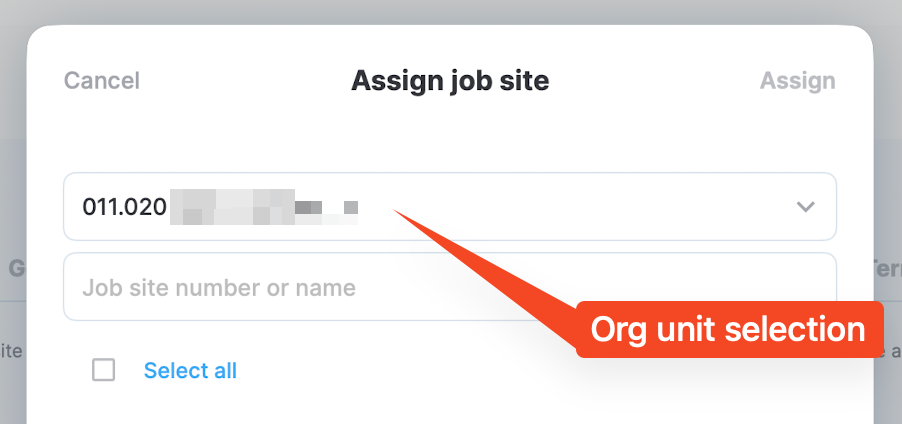
Selecting an organization unit
When assigning job sites, the system limits available job sites based on the intersection of your org units and the employee's org units. You can only assign job sites from org units that both you and the employee have access to. For example, if you have access to org Units A, B, and C, while the employee has org unit A as their main unit and only org unit B as an additional one, you can only assign that employee to job sites in org units A and B.
After the organization unit is selected, job sites within the organization unit will appear in the list and can be assigned to the employee. See Additional organization units to learn more.
Face settings
Similar employees
Here, you have the list of all the other employee profiles that have been qualified by the system as similar to the given employee. The profile card of a similar employee includes a profile picture, status, name, and employee number. The following screenshot shows an example of a similar employee card.
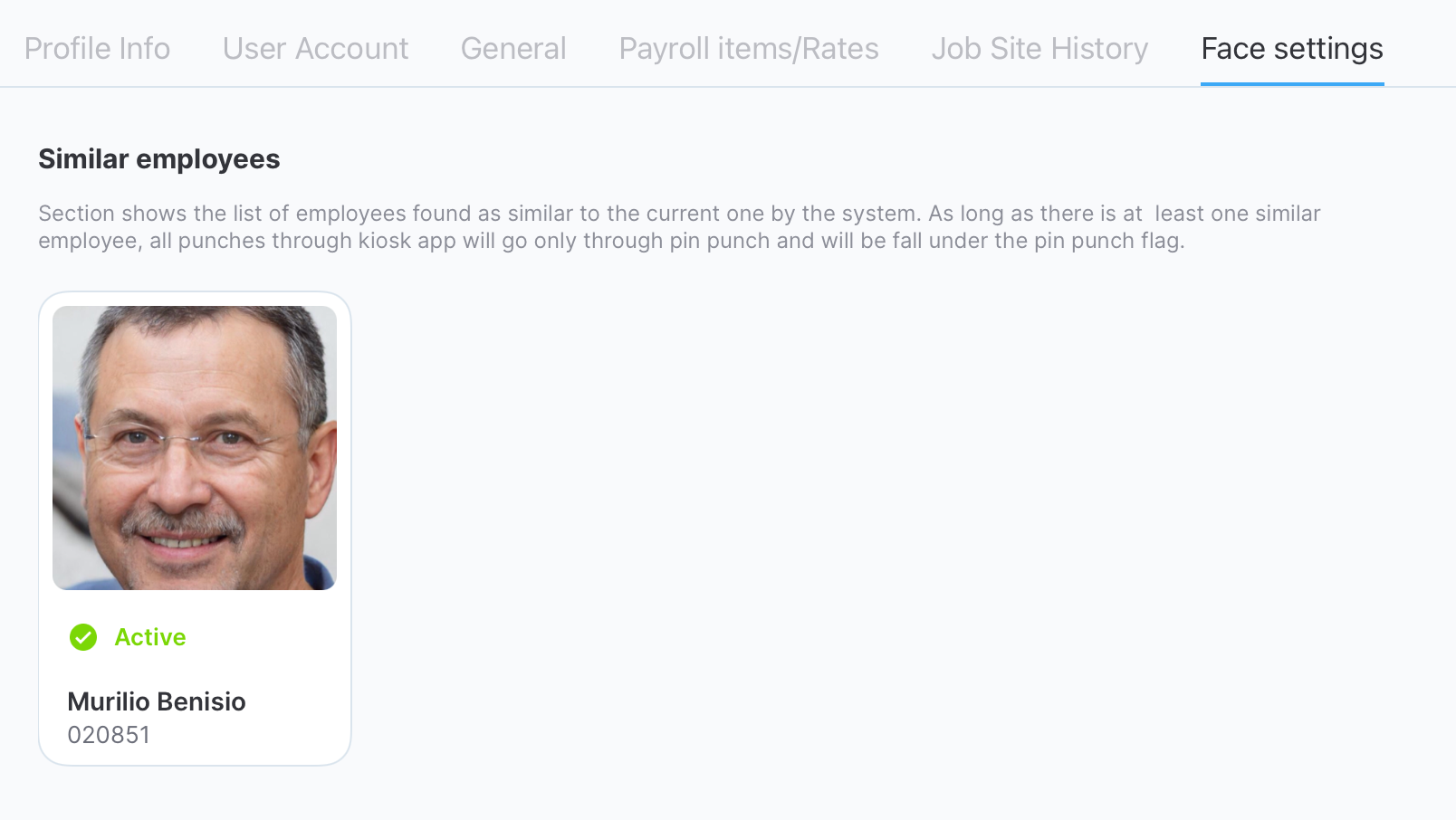
Similar employees example
NOTELocating similar employees can help you identify duplicate profiles (for instance, if the employee already had a profile but created a new one) and manage them.
Face library
This is a collection of all the photos that were taken for punch-in but were not recognized by the system.
For a photo to appear here, it first needs to be added to Face Library from the employee’s timelog that contains the unrecognized punch-in photo.
Once the photo is in Face Library, you can remove it or add it as a profile photo. This can be useful if, for instance, the appearance of the employee has changed, and the profile photo needs to be updated to reflect the current appearance.
Accepted Terms
In this section, you see the history of all the documents, such as an affidavit, accepted by the employee. The following screenshot shows an example of a list of accepted documents.
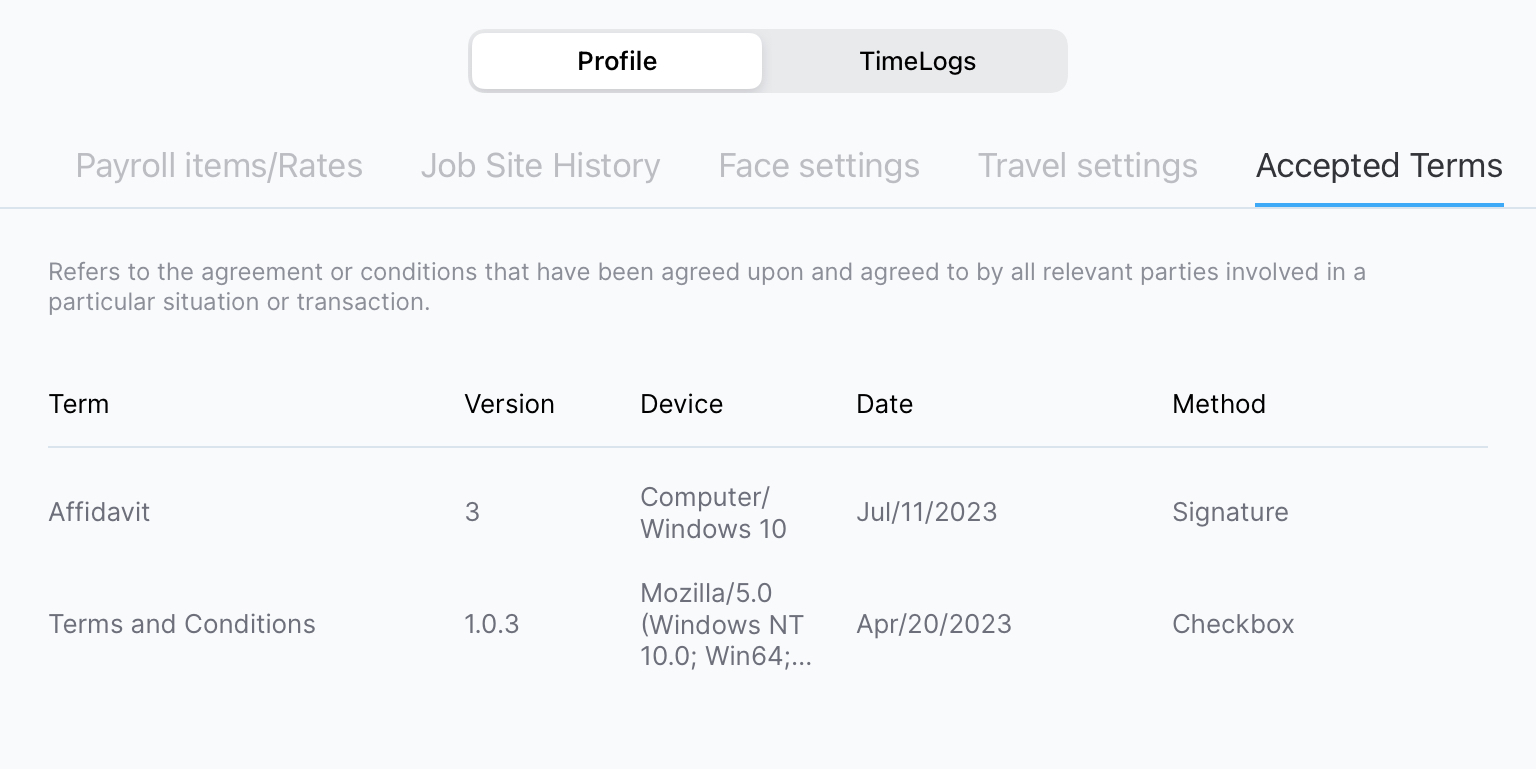
List of accepted documents
Updated 2 months ago